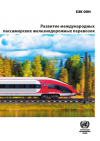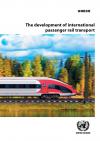Publications
Displaying Results 41 - 60 of 272
- Pусский
В последние годы во всем мире наблюдается стремительное развитие сетей высокоскоростных железных дорог (ВСЖД). Опыт государств, эксплуатирующих эти системы, показывает, каким образом они устанавливают новые стандарты качества и способствуют возрождению железных дорог как одного из видов транспорта. Развитие сети ВСЖД в регионе ТЕЖ позволит значительно улучшить конкурентоспособность
- Français
Le transport ferroviaire à grande vitesse se développe rapidement partout dans le monde depuis plusieurs années. Dans les pays qui mettent en place ce type de services, on observe que la grande vitesse, grâce à ses normes de qualité élevées, contribue au renouveau du chemin de fer. La création d'un réseau à grande vitesse dans la région du TER renforcerait considérablement la compétitivité du
- English
The construction and maintenance of road infrastructure is an important area of most countries’ national economies, but also one of the least digitized sub-sectors. It suffers from the presence of systemic shortcomings including an insufficient level of cooperation, inadequate information management, and limited investment in technology, research and development. These shortcomings often result
- English
The Trans-European North-South Motorway (TEM) Project was initiated to facilitate road traffic in Central, Eastern and South-Eastern Europe and to assist with the process of integrating European transport infrastructure systems.
One of the objectives of the Project is to improve the road network’s management. This report aims to provide TEM member countries with up-to-date information about how
- English
The Trans-European North-South Motorway (TEM) Project was initiated to facilitate road traffic in Central, Eastern and South-Eastern Europe and to assist with the process of integrating European transport infrastructure systems.
In order to improve the road network’s management, the Project provides TEM member countries with benchmarking of the current capacities of asset management, with up-to-
- Pусский
Международные железнодорожные пассажирские перевозки имеют фундаментальное значение для перемещения людей через границы в регионе ЕЭК. Их центральная роль была подчеркнута в резолюции № 264 Комитета по внутреннему транспорту. Пандемия COVID-19, помимо негативных экономических последствий, которые еще предстоит преодолеть, дает возможность пересмотреть роль железнодорожного транспорта в регионе
- English
International rail passenger transport is of fundamental importance to the movement of people across borders in the ECE region. Its central role was highlighted in Inland Transport Committee Resolution No. 264. The COVID-19 pandemic offers, beyond its negative economic impacts that remain to be recovered from, the opportunity to reconsider the role of rail transport in the ECE region and further
- English
In 2010, the United Nations General Assembly (resolution 64/255) proclaimed a Decade of Action for Road Safety ("Decade"). As part of the Sustainable Development Goals (SDGs), the goal of the Decade (2011-2020) is to stabilize and then reduce the forecast level of road traffic deaths around the world.
SDG 3.6 By 2020 halve the number of global deaths and injuries from road traffic accidents
SDG
- Français
L’ADR, fait à Genève le 30 septembre 1957 sous l'égide de la Commission économique des Nations Unies pour l'Europe, est entré en vigueur le 29 janvier 1968.
Cet Accord est destiné à accroître la sécurité du transport international de marchandises dangereuses par route. Ses annexes A et B imposent les conditions dans lesquelles les marchandises dangereuses, lorsqu'elles ne sont pas interdites,
- English
Adopted on 30 September 1957 in Geneva under the auspices of the United Nations Economic Commission for Europe (UNECE), the ADR entered into force on 29 January 1968.
This authoritative Agreement is intended to increase the safety of international transport of dangerous goods by road. Its Annexes A and B contain the technical requirements for road transport, i.e. the conditions under which
- Pусский
Цель общеевропейских рекомендаций, применимых к судам внутреннего плавания, – установление согласованного режима технических требований к судам, участвующим в международных перевозках грузов и пассажиров. Они являются результатом усилий правительств, направленных на унификацию отличающихся друг от друга правил, действующих в различных международных организациях и в странах-членах ЕЭК ООН.
- Français
Les recommandations paneuropéennes pour les bateaux de navigation intérieure visent à établir un régime harmonisé de prescriptions techniques pour les bateaux qui transportent des marchandises et des passagers au niveau international. Ces recommandations sont le résultat des efforts déployés par les gouvernements pour unifier les réglementations divergentes en vigueur dans les différentes
- English
The pan-European recommendations for inland navigation vessels aim to establish a harmonized regime of technical requirements for vessels that transport goods and passengers internationally. The recommendations are the result of Government efforts to unify divergent regulations in force in different intergovernmental organizations and ECE member countries.
The recommendations were first adopted
- Français
Il existe 59 instruments juridiques onusiens dans le domaine des transports intérieurs qui sont administrés par le Comité des Transports Intérieurs de la Commission Economique des Nations Unies pour l'Europe (CEE-ONU). Parmi les 59 conventions, sept instruments dans le domaine de la sécurité routière sont considérés comme des priorités pour l’adhésion:- 1968 Convention sur la circulation
- Español
Existen 59 instrumentos jurídicos de las Naciones Unidas en el ámbito del transporte terrestre que son administrados por la Comisión Económica de las Naciones Unidas para Europa (CEPE). De las 59 convenciones, siete instrumentos se consideran prioritarios en seguridad vial para la adhesión:- Convención de 1968 sobre la circulación vial;- Convención de 1968 sobre la señalización vial;- Acuerdo
- English
There are 59 United Nations legal instruments in the area of inland transport which are administered by the United Nations Economic Commission for Europe (UNECE). Of the 59 conventions, seven road safety instruments are considered to be priorities for accession:
- 1968 Convention on Road Traffic;
- 1968 Convention on Road Signs and Signals;
- 1958 Agreement concerning the Adoption of
- English
ECE/TRANS/290,
Sales No. E.20.VIII.2,
ISBN 978-92-1-117241-6,
Price: US$ 35,
Languages: E, F, R
The Agreement on the International Carriage of Perishable Foodstuffs and on the Special Equipment to be Used for such Carriage (ATP) was done at Geneva on 1 September 1970 and entered into force on 21 November 1976.
The objectives of the ATP are to facilitate international transport
- English
As part of the ongoing activities of the Working Party on Rail Transport (SC.2) a workshop titled “Making rail freight more competitive: The coordinated development of the rail network with a focus on how to work together at the government and sectoral levels on the EATL” was held at the seventy-third session of the Working Party.Over 60 participants from national administrations,
- English
While significant progress in improving road safety has been made in some countries in the last decade, the overall global results are far worse and changes are urgently needed to considerably reduce the number of global road fatalities and injuries. Road traffic injuries constitute the first cause of accidental death globally. Road traffic accidents are responsible for more than 1.3 million
- English
The UNECE “White Paper on the progress, accomplishment and future of sustainable inland water transport” is the third edition of a policy paper on the current situation, trends and challenges in inland water transport on European inland waterways of international importance in the region of the Economic Commission for Europe.This third edition follows from the International Conference on












